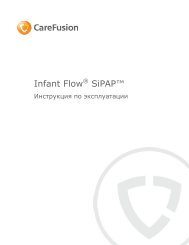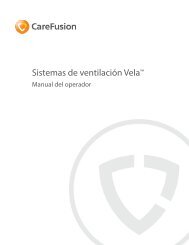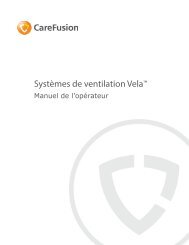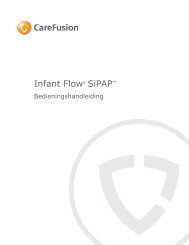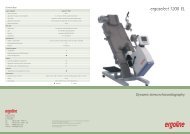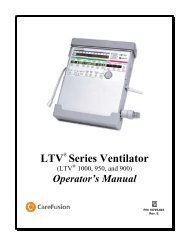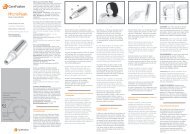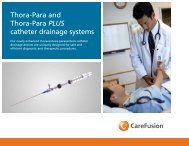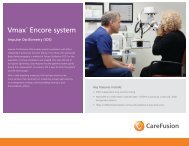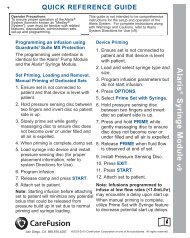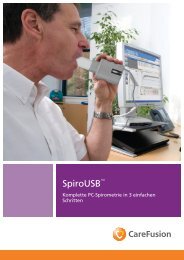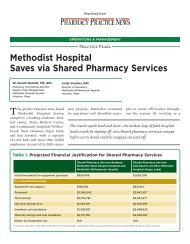Heparin: Improving Treatment and Reducing Risk of ... - CareFusion
Heparin: Improving Treatment and Reducing Risk of ... - CareFusion
Heparin: Improving Treatment and Reducing Risk of ... - CareFusion
Create successful ePaper yourself
Turn your PDF publications into a flip-book with our unique Google optimized e-Paper software.
HEPARIN SAFETY<br />
changes its thromboplastin reagent <strong>and</strong> can go in either direction.<br />
Failure to account for such change by updating heparin<br />
dosing schemes would have resulted in systematic underdosing<br />
<strong>of</strong> the vast majority <strong>of</strong> patients. For this reason, it is important<br />
that each institution adjust heparin dosing guidelines as necessary<br />
to the aPTT assay reagent currently in use.<br />
patients with lower UFH infusion rates can lead to underestimation<br />
<strong>of</strong> UFH anticoagulation. The presence <strong>of</strong> a heparin<br />
effect may not be appreciated because the ACT test is not<br />
designed to measure effects in the lower target range. Thus,<br />
while POC testing devices provide rapid results, such devices<br />
may sacrifice accuracy <strong>and</strong> precision.<br />
Pre-analytical Variables<br />
Pre-analytical variables that adversely affect aPTT test results<br />
include poor phlebotomy technique, incorrect or improperly<br />
filled blood collection tubes, delays in sample testing, temperature,<br />
<strong>and</strong> inadequate sample centrifugation prior to testing.<br />
Some drugs <strong>and</strong> disease states can also affect test results (Table<br />
2). Increased levels <strong>of</strong> fibrinogen <strong>and</strong> factor VIII (both acute<br />
phase reactants) may also reduce the aPTT result, leading to<br />
“heparin resistance.”<br />
Impact <strong>of</strong> Bolus Dosing<br />
Depending on the size <strong>of</strong> a heparin bolus, it can affect aPTT values<br />
for more than 6 hours. For example, 4 hours after a 5,000-<br />
unit bolus the aPTT result may suggest adequate heparinization,<br />
but a subsequent aPTT result may show that the continuous<br />
infusion is subtherapeutic. Earlier determination <strong>of</strong> aPTT value<br />
may be <strong>of</strong> benefit to determine if a rate increase should occur if<br />
the value is low.<br />
Point-<strong>of</strong>-Care (POC) Testing<br />
Test results will vary among POC devices <strong>and</strong> typically do not<br />
match laboratory aPTT results, because <strong>of</strong> differences in the<br />
sample type, clot-detection method, <strong>and</strong> incubation period.<br />
There are also differences between ACT manufacturers <strong>and</strong> cartridge<br />
types. A different ACT test may be used depending on the<br />
desired degree <strong>of</strong> heparin effect is being followed, which can<br />
vary between methods. Use <strong>of</strong> high-dose ACT cartridges in<br />
• Preanalytical<br />
• Poor phlebotomy technique!!!!<br />
• Time <strong>and</strong> temperature (for UFH monitoring, sample should be tested<br />
within 2 hours <strong>of</strong> collection)<br />
• Centrifugation-platelet poor (300 reagent—Instrument combinations<br />
• No st<strong>and</strong>ardization <strong>of</strong> reagents (despite attempts)<br />
• Reagent variability<br />
• Phospholipid concentration<br />
• Activator type<br />
• Influences on test<br />
• Increases in factor levels-acute phase ( aPTT)<br />
• Decreases in factor levels ( aPTT)<br />
• Drug effect ( or aPTT)<br />
• Lupus anticoagulant (may aPTT)<br />
Table 2. aPTT Test Variables<br />
Anti-Xa monitoring <strong>of</strong> UFH treatment<br />
Most institutions that measure anti-Xa activity use either a clot<br />
based or a chromogenic method. While this test is more robust<br />
than the aPTT <strong>and</strong> may be less adversely affected by pre-analytical<br />
variables, test calibration variability <strong>and</strong> methodology differences<br />
can result in a wide range <strong>of</strong> anti-Xa levels reported,<br />
(CAP, 2008).<br />
Administration<br />
The most common type <strong>of</strong> heparin-related error is also the type<br />
most likely to be associated with patient harm—administration<br />
<strong>of</strong> an improper dose or quantity (Santell, 2008). Pooled data<br />
from 54 hospitals using smart IV pumps revealed that heparin<br />
was the number one drug associated with averted errors, i.e.,<br />
smart pump alerts that resulted in reprogramming. Some<br />
errors, if not averted, would have infused dosages 50- to 100-<br />
times above or below the pre-established drug-library<br />
limits.(Cardinal Health, 2008) Analysis <strong>of</strong> smart-pump data at a<br />
regional healthcare system showed that 93% <strong>of</strong> high-risk heparin<br />
errors averted by smart pump use occurred in non-criticalcare<br />
settings (Williams et al., 2006).<br />
A frequent, potentially dangerous practice involves administering<br />
bolus doses from continuous infusions, rather than<br />
preparing a loading dose or subsequent bolus dose in a separate<br />
container such as a syringe or mini-bag. Serious errors can also<br />
occur in calculating dosage changes from an initial loading dose<br />
in units/kg to continuous infusion in units/kg/hr or units/hr.<br />
Unnecessary variability in heparin<br />
concentrations, nomenclature <strong>and</strong> dosing<br />
units further increases opportunities<br />
for error. A review <strong>of</strong> smart-pump<br />
drug libraries in 207 hospitals identified<br />
14 different heparin concentrations<br />
being used in various facilities.<br />
<strong>Heparin</strong> nomenclature also varied<br />
widely, with 191 different namedescriptors<br />
(Bates et al., 2005). Data<br />
from a 54-hospital sample showed that<br />
48% <strong>of</strong> hospitals had st<strong>and</strong>ardized dosing<br />
units on units/kg/hr, 22% used only<br />
units/hr <strong>and</strong> 30% allowed either<br />
weight-based or non-weight-based<br />
dosing units. When both dosing units<br />
were available, there was a four-fold<br />
increase in smart pump alerts that led<br />
to infusion reprogramming, i.e., averted<br />
errors (Cardinal Health, 2008).<br />
To reduce opportunities for such<br />
22<br />
Patient Safety & Quality Healthcare ■ January/February 2009 www.psqh.com



